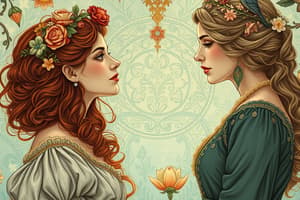Podcast
Questions and Answers
How are stage and film versions of a drama similar? (Check all that apply)
How are stage and film versions of a drama similar? (Check all that apply)
- The viewer must imagine the setting.
- The viewer must infer the characters' emotions and motivations from the actors' portrayals. (correct)
- The viewer must interpret the setting to understand the story's context. (correct)
- The viewer must infer the mood from lighting and sound effects. (correct)
- The viewer must visualize the action.
What are the advantages of reading a play instead of watching it or listening to it? (Check all that apply)
What are the advantages of reading a play instead of watching it or listening to it? (Check all that apply)
- Readers can interpret stage directions. (correct)
- Readers can envision different interpretations. (correct)
- Readers can review scenes and dialogue. (correct)
Why might a director or screenwriter make changes to the original version of a story? (Check all that apply)
Why might a director or screenwriter make changes to the original version of a story? (Check all that apply)
- To remove scenes that seem unnecessary to the plot or the overall theme. (correct)
- To add action and excitement. (correct)
- To simplify the story and avoid confusion. (correct)
- To cut the story to an appropriate length for a radio, film, or TV version. (correct)
- To update an older story for a modern-day audience. (correct)
How might an audio recording reflect the setting in this passage? (Check all that apply)
How might an audio recording reflect the setting in this passage? (Check all that apply)
How would an audio recording most likely indicate the characters' emotions during this scene?
How would an audio recording most likely indicate the characters' emotions during this scene?
How would a film version most likely indicate the characters' emotions during this scene?
How would a film version most likely indicate the characters' emotions during this scene?
Where should the camera focus if the director wants to emphasize the women's emotions?
Where should the camera focus if the director wants to emphasize the women's emotions?
Which medium (print, audio, stage, or film) do you think would best interpret this passage? Support your answer with two examples.
Which medium (print, audio, stage, or film) do you think would best interpret this passage? Support your answer with two examples.
Flashcards are hidden until you start studying
Study Notes
Similarities Between Stage and Film Versions
- Staging requires the viewer to imagine the setting, as it’s not physically manifested.
- Character emotions and motivations are inferred from actors’ performances.
- Action visualization is necessary since it unfolds in real-time without narration.
- Mood is interpreted through lighting and sound effects, essential for audience immersion.
- Understanding the story's context depends on interpreting the setting depicted on stage or screen.
Advantages of Reading a Play
- Readers have the opportunity to interpret stage directions that guide performance.
- Ability to review scenes and dialogue allows for deeper understanding and analysis.
- Engaging with the text fosters the imagination to envision various interpretations, enhancing literary appreciation.
Reasons for Adaptations by Directors or Screenwriters
- Enhancements for action and excitement can make narratives more engaging for audiences.
- Removal of unnecessary scenes tightens the plot, maintaining narrative focus.
- Shortening for suitability in formats like radio, film, or TV ensures concise storytelling.
- Modernizing older stories can make them relevant for contemporary viewers.
- Simplifying complex narratives avoids confusion, aiding audience comprehension.
Audio Recording Reflection of Setting
- Sound effects such as clanging pans can vividly portray the environment.
- Characters’ tones of voice contribute to the overall atmosphere and emotional context.
- Reading stage directions aloud provides clarity on the intended actions and settings.
- Footstep sound effects serve to ground the listener in the physical space of the narrative.
Indicating Characters' Emotions in Audio
- Tone of voice is a crucial indicator, conveying nuances of emotion without visual aids.
Indicating Characters' Emotions in Film
- Facial expressions are pivotal in film, visually communicating the characters’ internal states.
Camera Focus for Emphasizing Women's Emotions
- Close-ups of female characters provide intimacy and depth, underscoring their emotional states.
Best Medium for Interpreting the Passage
- The script format indicates a visual storytelling approach, most effectively realized through film.
- Cinematic techniques, such as close-ups on characters’ eyes, enhance emotional connection.
- Key moments, like the turning of a knob, create tension and focus through camera movements, accentuating pivotal narrative elements.
Studying That Suits You
Use AI to generate personalized quizzes and flashcards to suit your learning preferences.


